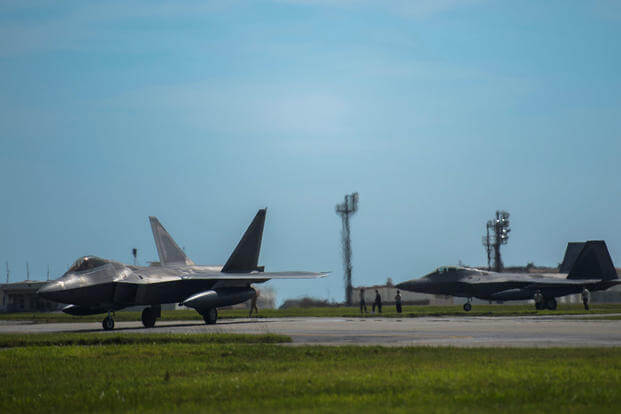The F-22 Raptor has deployed to the Pacific as part of a theater security mission, swapping in for the Air Force's F-35 Joint Strike Fighter.
Fifth-generation fighters, aircrew and support personnel from the 525th Fighter Squadron at Joint Base Elmendorf-Richardson, Alaska, arrived this week at Kadena Air Base, Japan, as the new theater security package, a term describing forward-deployed aircraft units that conduct missions to reassure partner and ally forces and maintain security and stability across a region.
The number of fighters that deployed was not disclosed.
"Pacific Air Forces TSP deployments to the Indo-Pacific region signify a continued commitment to regional stability and security and have served as a routine and integral part of U.S. Indo-Pacific Command's force posture since March 2004," Kadena's 18th Wing said in a release Thursday.
Related content:
- America's Largest Combatant Command Is Getting a New Name
- US, Allies 'Blitz' Korea with Massive Air Power Display
- Air Force Sees Unique Challenges in Deploying Stealth Fighters
F-22s have routinely deployed to Kadena over the last decade.
In December, a massive force totaling 230 aircraft participated in U.S.-led drills dubbed Vigilant Ace 18 with South Korean allies at Osan Air Base to focus on "interoperability, security and combat airpower," officials said at the time.
The exercise included six F-22 twin-engine jets, six F-35A Lighting II single-engine jets and a dozen F-35B vertical takeoff jets.
In 2016, F-22s alongside U.S. F-16 Fighting Falcons deployed to Yokota Air Base weeks after North Korea claimed it had conducted an underground nuclear hydrogen test. They were last at Kadena in 2014, the 18th Wing said.
F-35As recently returned to Hill Air Force Base, Utah, from Kadena after a six-month rotation in theater. The mission marked the first operational deployment overseas for the Air Force's version of the Joint Strike Fighter.
But the Pentagon's premier multirole fighter is still in the Pacific.
In March, the Marine Corps' F-35B short takeoff/vertical landing jet deployed for the first time aboard the amphibious assault ship Wasp. The service last year also deployed a squadron of F-35Bs to Iwakuni, Japan.
The F-22s will align under the newly renamed U.S. Indo-Pacific Command while in the region. Defense Secretary Jim Mattis announced Wednesday that the U.S. military's largest command would change its name from U.S. Pacific Command to U.S. Indo-Pacific Command.
"Our 2018 National Defense Strategy is the first of its kind in a decade, and it acknowledges ... America's resolve and lasting commitment to the Indo-Pacific," Mattis said during a change-of-command ceremony at Joint Base Pearl Harbor-Hickam in Hawaii.
"America continues to invest vigorously in Indo-Pacific stability, bolstering the free and open rules-based international order that has enabled this region to grow and to thrive for over 70 years," he said.
-- Oriana Pawlyk can be reached at oriana.pawlyk@military.com. Follow her on Twitter at @Oriana0214.










